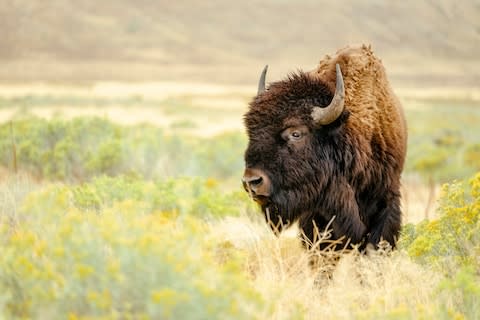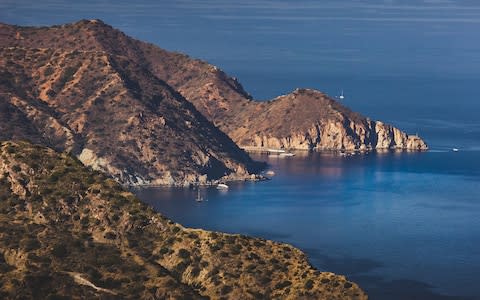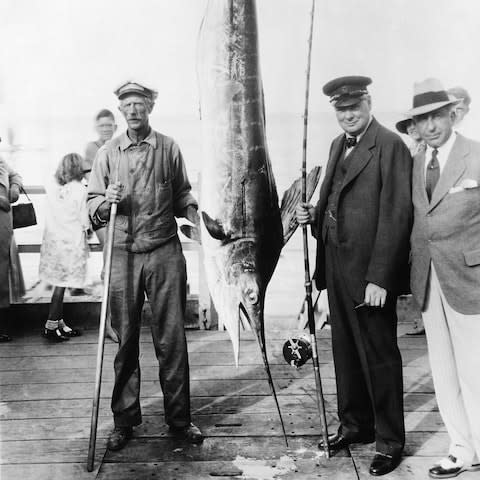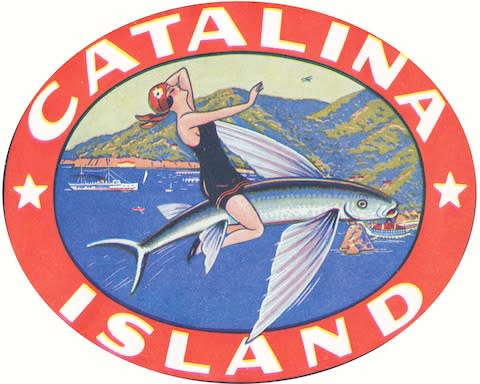The idyllic Californian island you might confuse with the Med
![Avalon resembles the Cote d’Azur, with its pretty harbour, Mediterranean-style homes built into the verdant hillsides and Art Deco casino - Copyright (C) 2017 Focqus, LLC. (Copyright (C) 2017 Focqus, LLC. (Photographer) - [None]](https://s.yimg.com/ny/api/res/1.2/8cUPMKYGb_LZvs.hdLdCmg--/YXBwaWQ9aGlnaGxhbmRlcjt3PTEyNDI7aD03Nzc-/https://media.zenfs.com/en-GB/homerun/the_telegraph_258/3dfcdf949591c038aa4b5aeeb9bfc7e3)
When you think of Californian beaches you think of the roiling surf of Malibu, with its surfers catching waves, or the epic stretches of sand in wealthy Orange County. What you probably don’t think of are calm Mediterranean-style bays with sweet little fishing boats and crystal clear waters as still as a lake. But that’s exactly what you’ll find on Catalina, one of California’s Channel Islands, just an hour southwest of Los Angeles. And yet, most people have never heard of it.
I cannot fathom why it isn’t better known. Considering how far away LA is from most places (it’s a six-hour flight to the East Coast and over ten hours to Europe) and the relative ease of visiting this most picturesque of the Channel Islands (Catalina is a one-hour ferry ride from Long Beach), you’d think it would appear near the top of most Californian attractions lists. It certainly used to; in the 20th century this was a haven for Hollywood film stars, business tycoons and politicians.
The island, which is just 21 miles long and eight miles wide, was first purchased in 1892 by three Californian brothers, William, Joseph and Hancock Banning, with the goal of turning it into a resort destination. But they quickly ran into financial issues, forcing them to sell off a large number of shares. One of the investors that stepped in was chewing gum magnate William Wrigley Jr, who fell in love with the island when he visited with his wife Ada in 1919. He invested millions to build many of the island’s key attractions, including the iconic Catalina Casino and the island’s most luxurious hotel, Mt. Ada, in the couple’s former hilltop home overlooking the harbour.

The island is split into two sides: the main port of Avalon, where the ferries dock and most of the hotels and attractions are, and the more wild Two Harbors on the opposite side. Avalon resembles the Cote d’Azur, with its pretty harbour, Mediterranean-style homes built into the verdant hillsides and Art Deco casino, which wouldn’t look out of place in Monaco, jutting out over the water. Two Harbors, a short speedboat ride from Avalon, looks more like a Greek island, with its arid sun-bleached landscape, tranquil turquoise waters and Mykonos-style beach club.
It was Wrigley’s idea to bring Hollywood to the island and he hosted various A-list stars and movie producers at his home, which led to the island being used as the backdrop for many blockbusters of the Twenties and Thirties, the most famous of which was Mutiny on the Bounty, which scooped the Oscar for Best Picture in 1932. The island’s film legacy also explains one of their more unusual inhabitants – a herd of Great Plains bison. When The Vanishing American was being filmed on the island in 1924, one of the scenes required bison, and so the film crew brought 14 over with the intention of returning them afterwards. When the film’s funds dried up, the bison had to stay put and now hundreds roam the island.

As well as bison you’re likely to spot native creatures like bald eagles, foxes and deer – the Wrigley family turned 80 per cent of the island into a conservation area to keep the wildlife protected. Today some of the island’s most popular tourist activities include safaris in open-air, biofuel Hummers to explore the rugged scenery, as well as well as ocean tours to discover one of America’s most diverse marine ecosystems, home to dolphins, whales, seals and the California flying fish.
Over the years the island has played host to numerous big-name stars, including John Wayne, Charlie Chaplin, Judy Garland and Henry Fonda. Marilyn Monroe even lived on Catalina for a year during the Second World War when she was still Norma Jean Baker and her first husband, James Dougherty, was stationed there as a Merchant Marine. More recent famous visitors include Katy Perry and Taylor Swift, who came with a troupe of pals including Lorde and the band Haim in 2015. The island also became a favourite getaway for politicians, with Reagan, Nixon and Herbert Hoover all visiting. When Winston Churchill came to stay in 1929 he caught an 188lb marlin off the coast of Avalon in less than 20 minutes.

There are very few cars allowed on the island (and a 20-year waiting list for anyone wanting to bring one over), so most locals get around on foot or by bicycles or golf cart. It makes for a pleasantly slow pace of life, so different from LA’s hectic high streets and gridlocked freeways – days are spent either enjoying the beauty of the island, whether that’s taking the zip line eco tour that starts 600 feet above sea level, hiking to the Wrigley Botanic Garden, or relaxing on the golf course (the oldest operating west of the Mississippi) or at the enormous spa, with its terrace overlooking the ocean. Come the evening you’ll find everyone taking postprandial strolls up and down the harbour front, popping into friendly neighbourhood shops along the way, as you would in any Mediterranean seaside town. If you’re looking for a non-American getaway in America, this is the place to come.

How to get there
The Catalina Express high-speed catamaran departs daily from Long Beach, San Pedro and Dana Point, while the Catalina Flyer departs daily from Newport Beach. For more information visit www.visitcatalinaisland.com.